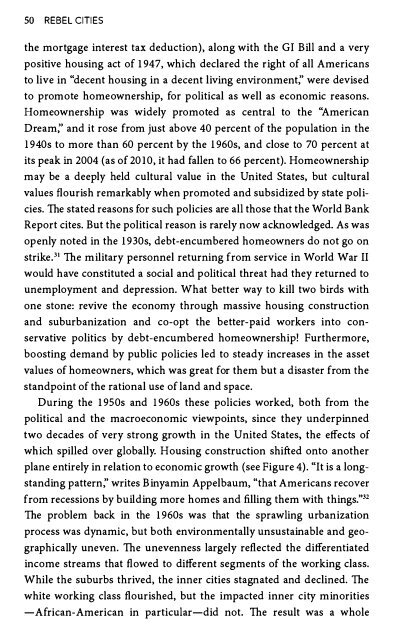Rebel Cities-David Harvey
Rebel Cities-David Harvey
Rebel Cities-David Harvey
- No tags were found...
You also want an ePaper? Increase the reach of your titles
YUMPU automatically turns print PDFs into web optimized ePapers that Google loves.
50 REBEL CITIESthe mortgage interest tax deduction), along with the GI Bill and a verypositive housing act of 1947, which declared the right of all Americansto live in "decent housing in a decent living environment;' were devisedto promote homeownership, for political as well as economic reasons.Homeownership was widely promoted as central to the "AmericanDream;' and it rose from just above 40 percent of the population in the1940s to more than 60 percent by the 1960s, and close to 70 percent atits peak in 2004 (as of2010, it had fallen to 66 percent). Homeownershipmay be a deeply held cultural value in the United States, but culturalvalues flourish remarkably when promoted and subsidized by state policies.The stated reasons for such policies are all those that the World BankReport cites. But the political reason is rarely now acknowledged. As wasopenly noted in the 1930s, debt-encumbered homeowners do not go onstrike.31 The military personnel returning from service in World War IIwould have constituted a social and political threat had they returned tounemployment and depression. What better way to kill two birds withone stone: revive the economy through massive housing constructionand suburbanization and co-opt the better-paid workers into conservativepolitics by debt-encumbered homeownership! Furthermore,boosting demand by public policies led to steady increases in the assetvalues of homeowners, which was great for them but a disaster from thestandpoint of the rational use of land and space.During the 1950s and 1960s these policies worked, both from thepolitical and the macroeconomic viewpoints, since they underpinnedtwo decades of very strong growth in the United States, the effects ofwhich spilled over globally. Housing construction shifted onto anotherplane entirely in relation to economic growth (see Figure 4). "It is a longstandingpattern," writes Binyamin Appelbaum, "that Americans recoverfrom recessions by building more homes and filling them with things."32The problem back in the 1960s was that the sprawling urbanizationprocess was dynamic, but both environmentally unsustainable and geographicallyuneven. The unevenness largely reflected the differentiatedincome streams that flowed to different segments of the working class.While the suburbs thrived, the inner cities stagnated and declined. Thewhite working class flourished, but the impacted inner city minorities-African-American in particular-did not. The result was a whole


